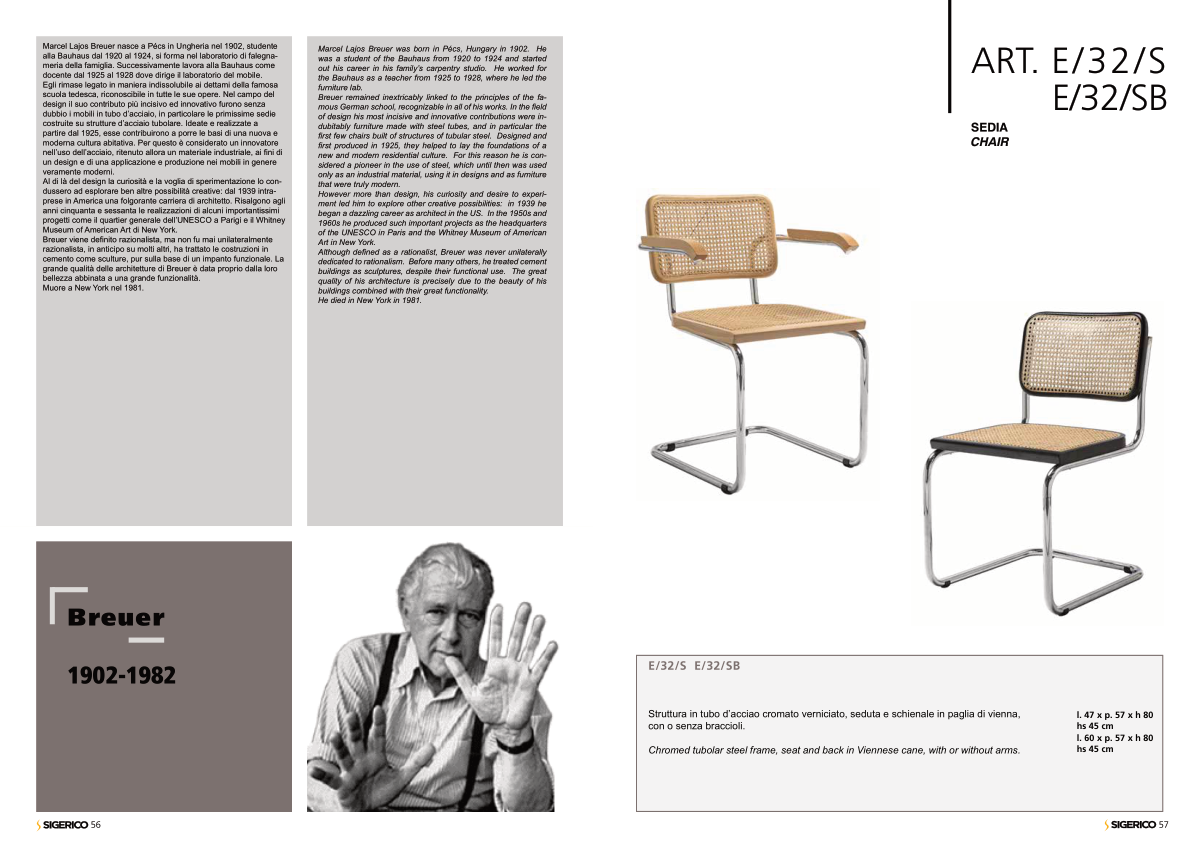Breuer
1902-1982
Marcel Lajos Breuer nasce a Pécs in Ungheria nel 1902, studente
alla Bauhaus dal 1920 al 1924, si forma nel laboratorio di falegna-
meria della famiglia. Successivamente lavora alla Bauhaus come
docente dal 1925 al 1928 dove dirige il laboratorio del mobile.
Egli rimase legato in maniera indissolubile ai dettami della famosa
scuola tedesca, riconoscibile in tutte le sue opere. Nel campo del
design il suo contributo più incisivo ed innovativo furono senza
dubbio i mobili in tubo d’acciaio, in particolare le primissime sedie
costruite su strutture d’acciaio tubolare. Ideate e realizzate a
partire dal 1925, esse contribuirono a porre le basi di una nuova e
moderna cultura abitativa. Per questo è considerato un innovatore
nell’uso dell’acciaio, ritenuto allora un materiale industriale, ai fini di
un design e di una applicazione e produzione nei mobili in genere
veramente moderni.
Al di là del design la curiosità e la voglia di sperimentazione lo con-
dussero ad esplorare ben altre possibilità creative: dal 1939 intra-
prese in America una folgorante carriera di architetto. Risalgono agli
anni cinquanta e sessanta le realizzazioni di alcuni importantissimi
progetti come il quartier generale dell’UNESCO a Parigi e il Whitney
Museum of American Art di New York.
Breuer viene definito razionalista, ma non fu mai unilateralmente
razionalista, in anticipo su molti altri, ha trattato le costruzioni in
cemento come sculture, pur sulla base di un impanto funzionale. La
grande qualità delle architetture di Breuer è data proprio dalla loro
bellezza abbinata a una grande funzionalità.
Muore a New York nel 1981.
Marcel Lajos Breuer was born in Pécs, Hungary in 1902. He
was a student of the Bauhaus from 1920 to 1924 and started
out his career in his family’s carpentry studio. He worked for
the Bauhaus as a teacher from 1925 to 1928, where he led the
furniture lab.
Breuer remained inextricably linked to the principles of the fa-
mous German school, recognizable in all of his works. In the field
of design his most incisive and innovative contributions were in-
dubitably furniture made with steel tubes, and in particular the
first few chairs built of structures of tubular steel. Designed and
first produced in 1925, they helped to lay the foundations of a
new and modern residential culture. For this reason he is con-
sidered a pioneer in the use of steel, which until then was used
only as an industrial material, using it in designs and as furniture
that were truly modern.
However more than design, his curiosity and desire to experi-
ment led him to explore other creative possibilities: in 1939 he
began a dazzling career as architect in the US. In the 1950s and
1960s he produced such important projects as the headquarters
of the UNESCO in Paris and the Whitney Museum of American
Art in New York.
Although defined as a rationalist, Breuer was never unilaterally
dedicated to rationalism. Before many others, he treated cement
buildings as sculptures, despite their functional use. The great
quality of his architecture is precisely due to the beauty of his
buildings combined with their great functionality.
He died in New York in 1981.
ART. E/32/S
SEDIA
CHAIR
E/32/SB
Struttura in tubo d’acciao cromato verniciato, seduta e schienale in paglia di vienna,
con o senza braccioli.
Chromed tubolar steel frame, seat and back in Viennese cane, with or without arms.
l. 47 x p. 57 x h 80
hs 45 cm
57
56
l. 60 x p. 57 x h 80
hs 45 cm
E/32/S E/32/SB


